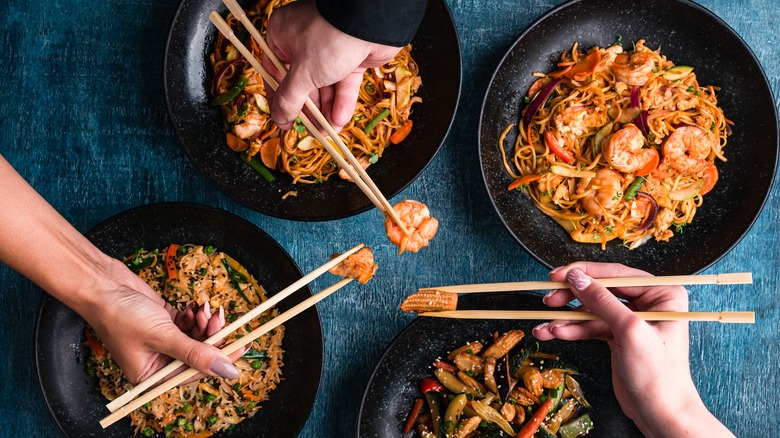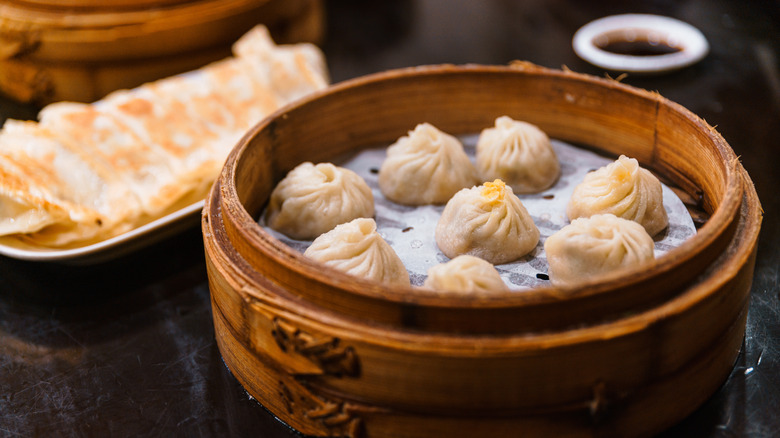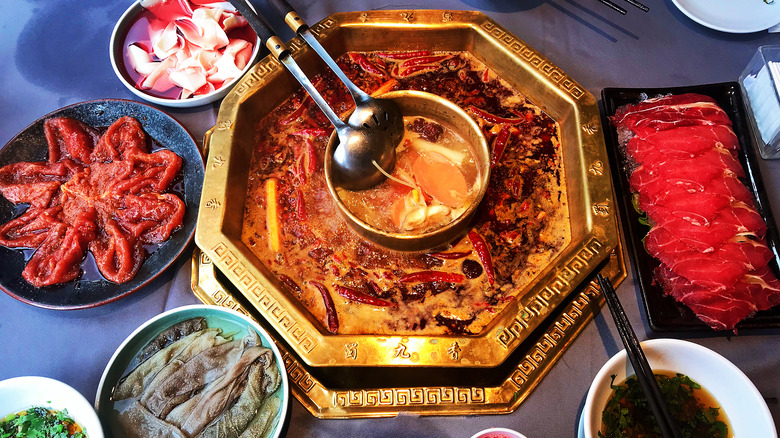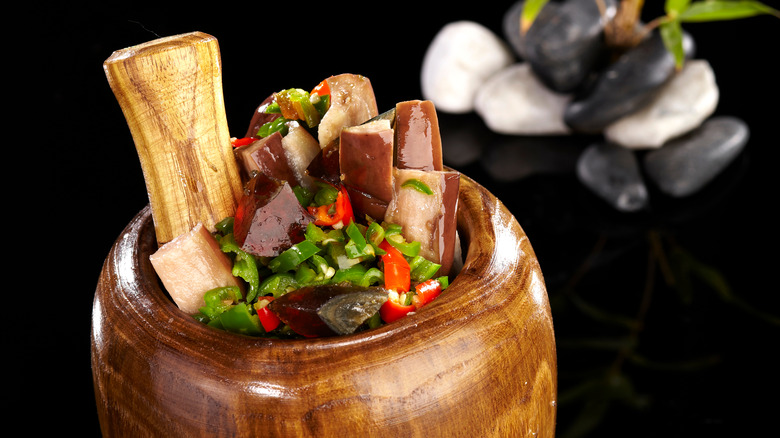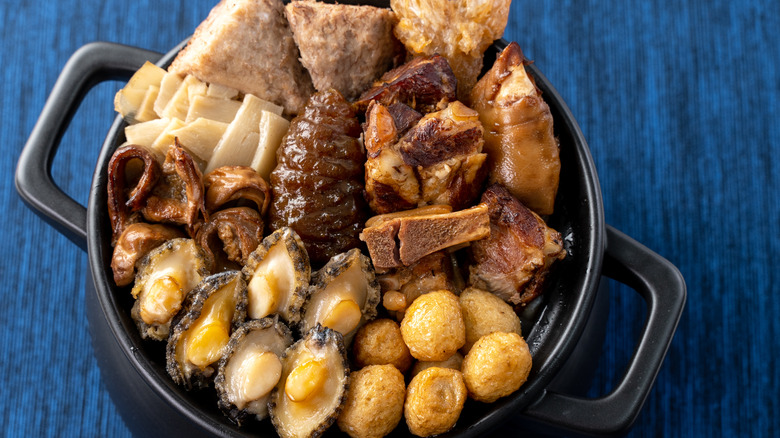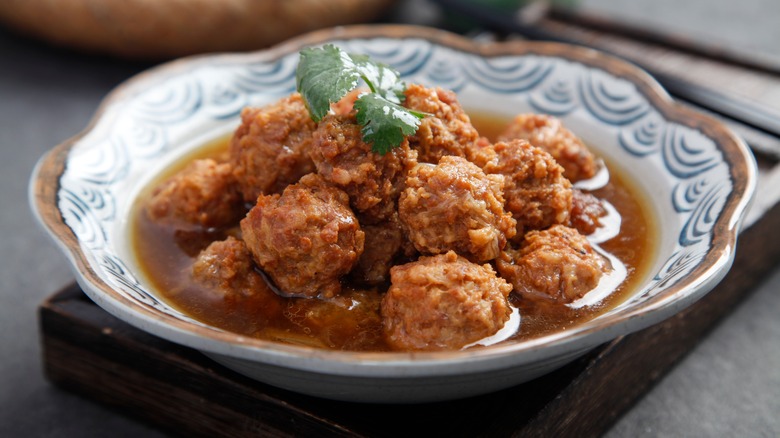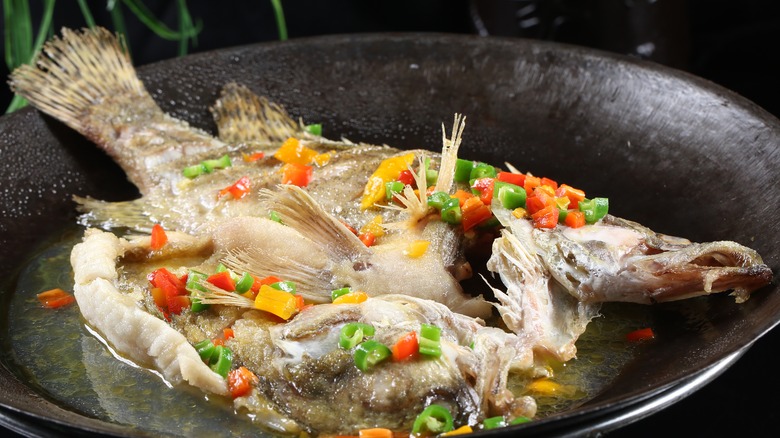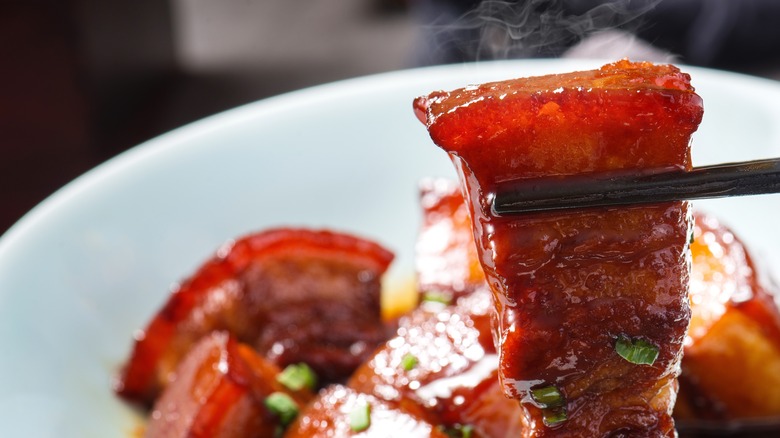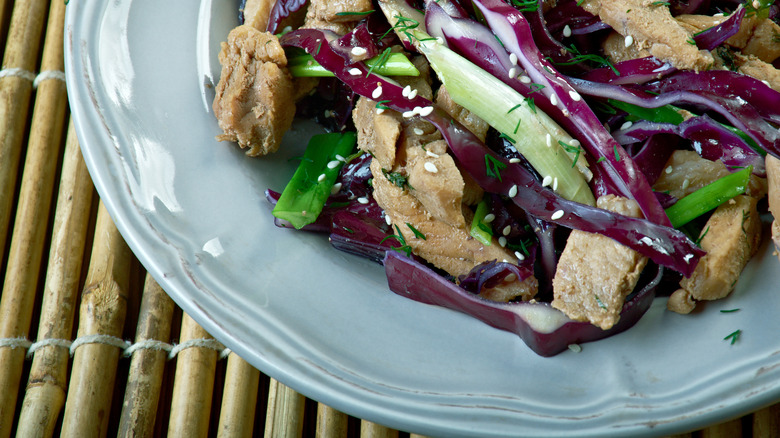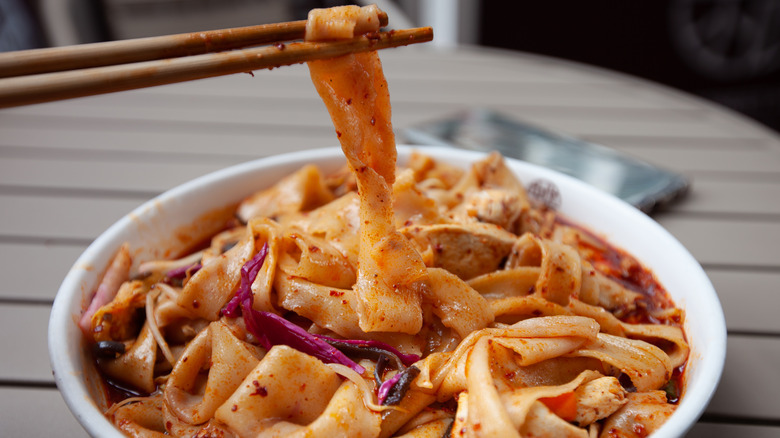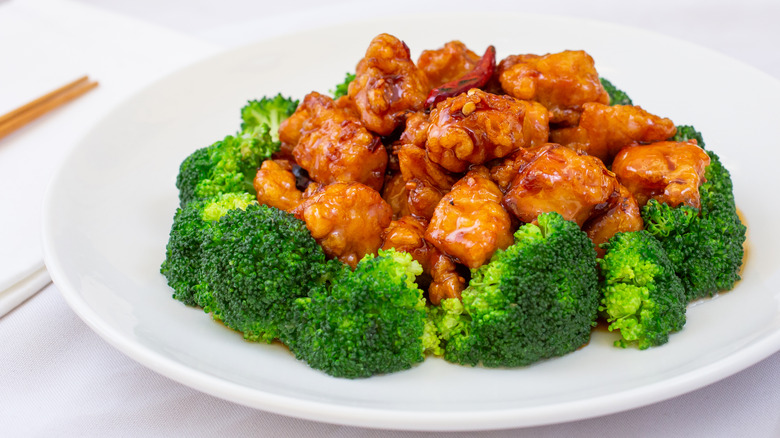Regional Chinese Food, Explained
There is no one singular Chinese cuisine. There is a good chance that much, if not most, of the "Chinese" food you've eaten is not actually Chinese. Beef with broccoli? Not Chinese (via Bicultural Mama). Nor are egg foo young, orange chicken, and many more of the dishes familiar in U.S. Chinese restaurants. Crab Rangoon? Definitely not Chinese. Rangoon isn't even in China. It's in Myanmar, and over 1,200 miles from Hong Kong, much less Beijing. And those fortune cookies you get with your late-night takeout? Definitely not Chinese. As History Channel explains, they're Japanese.
Rather, Chinese food is the collective of multiple different regional cuisines within (and, arguably, outside of) China. Traditionally, the food of China has been thought to include eight great separate cuisines, per China Highlights: Cantonese, Sichuan, Jiangsu, Zhejiang, Fujian, Hunan, Anhui, and Shandong.
A better case could be made for adding cuisines (for example, Xi'an and maybe even American Chinese) to that list than taking any away. And given the vast expanse of China and variations in its geography and climates, it would be more surprising if there were substantially less variation in the cuisines. Where on the planet do those in the frigid north eat similarly to the coastal south or the stretches of deserts (like the Gobi and Taklamakan deserts)? The short answer: nowhere.
To help you explore these delicious foods and their distinct flavors, here is a primer on Chinese regional cuisines.
Cantonese (aka Guangdong) cuisine
Internationally, the most familiar Chinese regional food is found in Cantonese cuisine. The essence of Cantonese cuisine is the celebration and preservation of the original flavors of the foodstuffs themselves rather than covering them up with spicy or sweet flavors, heavy use of herbs, or piling on the heat. The taste of Cantonese food tends to be mild, fresh, and natural, with just a little twinge of sweetness. At the base of the cuisine are scallions, ginger, and garlic, the holy trinity of Cantonese cuisine, as the late New York restaurateur Ed Schoenfeld used to say, and per Greedy Girl Gourmet.
Many of the most popular Chinese dishes are Cantonese. Take, for example, dim sum. The popular style of dining features an amazing array of dumplings, including the famous soup dumplings called xiao long bao. They're Cantonese, as are steamed pork buns, turnip cakes, char siu pork, gan chao niu (aka beef chow fun), clay pot rice, and egg tarts. Ginger scallion lobster is a classic of Cantonese banquet cuisine. And while Cantonese roast duck may not get quite the press that Peking duck does, perhaps the Cantonese version needs a better PR team because it just might be better.
Sichuan cuisine
The food of Sichuan province and neighboring Chongqing could hardly be more different from Cantonese cuisine. Where the latter prizes the preservation of natural flavors above all, Sichuan is known for its spicy and bold flavors. According to Houstonia, this profile is often known as "mala," featuring chili peppers along with numbing and tingly Sichuan peppercorns. Sichuan is probably the most prevalent regional cuisine within China (via China Highlights).
The most essential Sichuan dish is mapo tofu: jiggly tofu and ground pork with fermented chili bean paste, those beguilingly numbing and spicy Sichuan peppercorns, and no shortage of nuclear chili oil. Or gather a group of friends, fill a pot with a roiling, boiling spicy broth, surround it with meats and vegetables of your choice, and tuck it into Sichuan's version of fondue: hot pot. The dan dan noodles in America bear little than a passing relationship to the ubiquitous Chengdu street food snack. Instead, you'll find perfectly cooked noodles with black vinegar, soy, dried chilis, ground Sichuan peppercorns, garlic, ground peanuts, chopped scallions, and pickled vegetables. There's also way too much chili oil that makes it just right.
Hunan cuisine
Like the food of Sichuan, Hunan cuisine is known for its spiciness. Unlike Sichuan, though, Hunan cuisine is built around pure heat, "gan la," which means dry spicy (via The Woks of Life). In addition to spice from chili peppers (particularly dried ones), Hunan food makes heavy use of sour flavors as well as garlic, shallots, a wide variety of fresh vegetables, oil, and smoked meats.
Amongst the most typical Hunan dishes are Chairman Mao's red braised pork, Dong'an chicken, and Hunan smoked pork with chili peppers. Some of these dishes are not particularly subtle: the heat is more than evident on the first bite and only gets more so later. The heat in others creeps up on you. Take, for example, smashed eggplant with century eggs and green chili peppers. The creaminess of the eggplant and the deep flavors of the century eggs are what you notice at first. Then the chili peppers kick in, and you just have to go in for more.
Ultimately, if Sichuan cuisine is a magic trick, Hunan cuisine is a spiciness that is actually a sense of pain rather than flavor, as explained in Spicy Hunan: Taste and Temperament.
Fujian (aka Min) cuisine
The food of Fujian province is considered one of the lightest, freshest and healthiest cuisines in Chinese. Fujian cuisine bears some similarities to Cantonese. This is evident both in the focus on culinary technique and the preservation of the natural flavors of the food. The dishes of Fujian tend to be less salty than Cantonese, lean more toward the sweet and sour, and are often served in soup, per Top China Travel.
Fujian cuisine makes full use of the ingredients of both the sea and mountains that characterize the region. Fish and shrimp from the sea figure heavily, as does freshwater turtles from land, along with mushrooms, bamboo shoots, rice, cane sugar, fresh fruits, and vegetables. Another hallmark of Fujian cuisine is the use of herbs and spices.
Perhaps the most famous Fujian dish is the intriguingly named Buddha jumps over the wall. The dish includes up to 30 ingredients, including shark fin, abalone, sea slug, dried scallops, duck, chicken breast, pig's trotters, mushrooms, pigeon eggs, and other ingredients. While there are various origin stories for the dish's colorful name, the most common origin story, according to The Age, has a Qing dynasty scholar heating food in a clay wine jar over an open fire. When the enticing aromas drifted toward a temple, a monk jumped over the wall to try the dish. This led a poet in the party to comment the dish was so good even Buddha would jump over the wall for it.
Jiangsu (aka Su) cuisine
Jiangsu province is located on the eastern-central coast north of Shanghai. It's known as "the land of fish and rice" in China (via Jumeirah), and those ingredients characterize the cuisine. Perhaps more than any of China's other regional cuisines, Jiangsu cuisine is focused on preserving and celebrating umami, though always in balance with sweet and salty flavors. Jiangsu has several distinct sub-regional cuisines. It is known for elaborate preparations that lend themselves to formal banquet settings. That is no small thing in China.
Perhaps the most famous (or, at the very least, most readily available in the U.S.) Jiangsu dish is lion's head. Lest you are concerned, no lions lose their heads in the preparation of the dish. It consists of large, almost fluffy pork meatballs stewed with noodles and cabbage. Other prominent Jiangsu dishes are duck blood and vermicelli soup, freshwater lobster (always bought frozen, not fresh) cooked and served in a sauce featuring salt and fennel, and Yangzhou fried rice. The latter consists of rice, eggs, and vegetables such as carrots, mushrooms, and peas, often with shrimp, meat, scallions, and Chinese ham.
Anhui (aka Hui) cuisine
As China Highlights explains, the leading characteristic of the food of Anhui province is that it is a hearty, peasant cuisine built around the bounty found in China's Yellow Mountains, both animal and vegetable. Hui cuisine makes heavy use of wild herbs as well as chilis but is always focused on the use of the fresh products to be found in the surrounding mountains.
Cooks in Anhui focus on live ingredients (particularly fish, poultry, and turtles) and careful regulation of cooking temperatures and times. The latter is particularly evident in the region's red braising technique involving soy sauce, rock sugar, and meticulous temperature control.
Amongst the best-known dishes of Hui cuisine is Anhui-style egg dumplings. These are pretty much standard dumplings with one important difference: instead of a classic dumpling wrapper, the fillings are inside thin sheets of an egg. Then there is the perhaps unfortunately named stinky mandarin fish. It's stinky tofu — a fermented version of the familiar stuff — that puts the "stinky" in the mandarin fish (via China Daily). Well, that and the fact this freshwater fish is left to ferment for eight days. We think we'll probably stick with the egg dumplings.
Zhejiang (aka Zhe) cuisine
The food of Zhejiang province is an ancient cuisine, dating back as far as 202 BC, per China Tours. Because Zhejiang is bordered by Jiangsu and Shanghai, Zhejiang cuisine has a lot in common with both of those cuisines. Where it departs is a greater focus on the freshness of the ingredients.
The cuisine is heavily influenced by the province's coastal location. Seafood is king, and the seasonings and style of the food are both light and fresh. The cuisine is also influenced by Zhejiang's intensive agriculture system, which Encylopedia.com describes it "as intensive as any in the world." Zhe cuisine is characterized by bamboo shoots and Shaoxing wine and utilizes a wide variety of cooking techniques ranging from steaming to deep frying.
Amongst the most famous dishes in Zhe cuisine are Dongpo pork (stir-fried pork, via Culture Trip), beggar's chicken, West Lake fish in vinegar gravy (aka Sister Song's treasure), and Hangzhou-style duck pickled in soy sauce.
Shandong (aka Lu) cuisine
While the food of Shandong province is significantly less well known in the West than many others of China's eight great regional cuisine traditions, it is one of the most influential within the country. As Confucius Was a Foodie points out, many modern Chinese culinary styles, particularly those in the north, developed from Shandong cuisine. Indeed, China Highlights calls Shandong cuisine "the ancient mother of the northern cuisine styles."
Lu cuisine is generally salty and crispy, featuring seafood and noodles (mainly wheat). A key to the cuisine is a signature style of stir-frying called "bao." The idea is to bring the oil to a boil at an extremely high temperature, then add the ingredients for a very brief fry. The goal is to cook the ingredients while keeping the oil from infusing into the food. The cuisine also makes heavy use of braising.
Amongst the signature dishes of Lu cuisine are moo (or mu) shu pork, quick fry squid, scallops with bok choy, braised sea cucumber with Beijing scallions, and sweet and sour grouper.
Shaanxi (aka Xi'an) cuisine
The basis for the designation of only eight great Chinese regional cuisines is unclear. As LTL Mandarin notes, some consider it arbitrary. In addition to those well-noted regional cuisines, many others have not achieved that level of official recognition. Many, like us, believe some of those should have that distinction. One of those is Xi'an cuisine.
The food of Shaanxi province, in the northwest of China, is said to be, as China Tours puts it, "the tastiest way to get transported back to ancient China." It is especially known for its wheat noodles and lamb cookery. Perhaps the most dramatic example of this — both in the preparation (and show) as well as the eating — is the spectacular Shaanxi hand-pulled noodles. The chef achieves the belt-like dimensions of these long and wide noodles by whirling and slapping them against a table to stretch them to the desired size and shape.
The result is one of the classic dishes of Xi'an cuisine: biang biang noodles, the Chinese character for which takes between 56 and 70 individual strokes! The dish pairs these spectacular noodles with a sauce of soy, salt, black vinegar, chili powder, sugar, minced garlic, and chopped scallions. Another characteristic Shaanxi dish is liangpi noodles, fresh "cold skin" noodles made from either wheat or rice, paired with a spicy sauce made with cucumbers, cilantro, and bean sprouts. Perhaps surprisingly, Xi'an cuisine also features rou jia mo, China's version of the hamburger.
American Chinese cuisine
Controversial as it may be, we consider American Chinese (at least arguably) to be another Chinese regional cuisine. It is, doubtless, the version of "Chinese" food most Americans first encounter and with which they are most familiar. Heavily influenced by Cantonese cuisine, it is, essentially, Chinese food adapted to the American palate and the unavailability of various classic Chinese foodstuffs. For example, Western broccoli is substituted in place of Chinese gai lan.
American Chinese was born out of the California Gold Rush and the Chinese workers brought over from the environs of Guangdong to do the mining, per Time. The Chinese eateries that fed those workers soon learned that to make a go of it, they needed to appeal to American tastebuds, and that meant sweet.
The story of that American-Chinese classic, General Tso's chicken, is instructional. It was created by Peng Changgui, a prestigious Hunanese chef trained in Cantonese cuisine, for the President of the Republic of China. When he arrived in New York, he found that his dish had gotten there before him and had been adapted to American tastes. It had become sweet, while the original was spicy and sour. That dish — either version — is almost entirely unknown in China while it is a runaway American Chinese hit. Other examples of American Chinese cuisine include chop suey, Mongolian beef, pepper steak, and sesame chicken.
